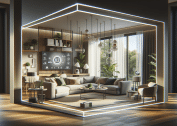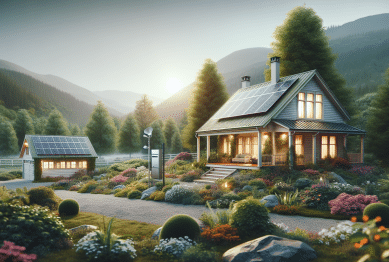Explore how indoor plants can transform even the smallest spaces into vibrant green sanctuaries. This guide delves into space-efficient planter selections, plant care techniques, and creative placement tips to help you nurture a thriving indoor garden regardless of your apartment size.
Creating Green Retreats In Limited Spaces
Living in an apartment or a home with minimal square footage doesn’t have to limit your gardening dreams. Indoor plants offer a transformative way to introduce greenery, even if your available area is small. Compact spaces can feel lighter and more inviting with just a few well-chosen planters. Selecting the right types of indoor plants—such as pothos, snake plants, or ZZ plants—can also mean less maintenance and higher adaptability. These resilient choices are celebrated for thriving in low light, making them perfect for apartments and studios. Many urban dwellers report feeling their rooms come alive after placing a few pots on windowsills or shelves.
It’s important to think vertically when adding greenery to compact interiors. Vertical planters, wall-mounted containers, and hanging baskets all provide opportunities to maximize your planting space. By elevating your indoor garden, you free up valuable surfaces while creating appealing living walls or cascading vine arrangements. This approach allows even the most modest rooms to feature a delightful array of foliage without causing clutter. Plus, vertical gardening adds an artistic aesthetic to your living environment and is a popular design choice among plant lovers who want to show personality through décor.
For renters or those with strict landlord policies, easy-to-move containers and no-drill hangers make plant arrangements possible without long-term alterations. Portable solutions let you experiment with placement to find the best light and visual balance. Some compact planters are designed specifically for desks, side tables, or countertops, helping you green up your space without sacrificing functionality. Many people discover that starting with a single shelf garden sparks inspiration and confidence to expand their indoor plant collection further.
Choosing The Right Indoor Plants For Success
Plant selection is vital to a thriving small-space indoor garden. Certain species adapt well to tight quarters, require minimal natural light, and tolerate occasional forgetfulness. Popular choices include succulents, philodendrons, and Chinese evergreens. These species are not only attractive but are also valued for being low-maintenance. For those who enjoy leafy growth, pothos and peace lilies are favorites, providing lush foliage even in indirect light settings. Knowing which varieties are beginner-friendly can save time, money, and frustration down the road.
Another consideration is air quality improvement. Several indoor plants function as natural air purifiers by absorbing toxins and releasing oxygen. The NASA Clean Air Study identified spider plants, mother-in-law’s tongue, and golden pothos as excellent detoxifiers. Introducing these into your living space can create a fresher, more breathable atmosphere. Healthy indoor air contributes to well-being and can make your home feel more comfortable, especially during seasons when windows are often closed.
Allergy concerns are also worth considering. While most indoor foliage is benign, some people are sensitive to pollen or certain plant saps. Researching which species are least likely to cause irritation ensures your green retreat is also a healthy one. Always look for non-toxic varieties if pets or children share your home. With mindful choices, your compact garden can provide beauty without any health worries.
Space-Smart Planters And Creative Arrangements
Efficient planter selection is essential for maximizing limited space. Look for containers that fold, stack, or are designed for multi-tiered displays. Modular planters allow you to customize arrangements as your needs shift. Hanging pots are especially helpful in kitchens and bathrooms, introducing greenery in spaces rarely used for traditional gardening. Window troughs, rail planters, and magnetic containers give additional flexibility for apartment dwellers trying to make the most of every nook.
Color and material play a role in the perceived spaciousness of a room. Light-colored or transparent planters blend with interiors, making the area look larger. Minimalist or geometric designs can make plant displays appear organized rather than overwhelming. Using repetition or symmetry as part of your arrangement brings a sense of harmony and order, a trick often used in interior design to calm busy-looking rooms.
Finally, don’t forget about repurposing items you already own. Mason jars, mugs, and unused bowls can create unique plant homes and reduce clutter. Upcycling these everyday pieces saves money and gives your garden a personal touch. Many discover the satisfaction of turning recycled objects into conversation starters. Get creative by mixing traditional pots with household finds for a sustainable, playful indoor garden.
Lighting, Watering, And Essential Plant Care
Understanding your space’s natural light is the first step to indoor plant care success. While some dwellings offer generous sunlight through south-facing windows, others require supplemental grow lights. Plants like snake plant and pothos can adapt to low light, but all will benefit from periodic exposure to indirect sunshine. Rotating pots ensures even growth, and monitoring seasonal sunlight patterns helps optimize placement throughout the year.
Watering needs vary widely between plant types. Overwatering is a common issue—especially in small pots with limited drainage. It’s important to learn the preferred moisture level for each species. Some, such as succulents, prefer soil to dry out completely between watering sessions. Others may need consistently moist soil. Incorporate a schedule or self-watering planters to avoid common pitfalls and keep your indoor garden healthy year-round.
Maintaining humidity and air circulation can make a significant difference to plant vitality in apartments. Misting leaves, using pebble trays, or grouping plants together helps increase local humidity, which is beneficial for tropical species. Proper airflow prevents mold and pests from developing. Simple acts, such as occasionally opening windows or training a fan on low speed, help maintain optimal conditions for diverse plant selections.
Maximizing Wellbeing And Benefits With Indoor Greenery
The positive effects of indoor plants extend well beyond aesthetics. Many people notice improved mood, reduced stress, and sharper concentration after adding green elements to their homes. Studies from reputable institutions confirm that just viewing living plants can lower blood pressure and elevate feelings of calmness. These benefits make indoor gardening appealing to those working from home or seeking a peaceful retreat from urban noise.
Plants also help control humidity and support respiratory health by releasing moisture and oxygen into the air. During drier seasons when indoor air can become stuffy, regular misting and smart plant placement keep your rooms feeling fresh. For those fighting allergies, certain species not only purify the air but also trap dust and particulate matter, acting as natural filters. Integrating greenery is an easy and affordable way to promote healthier living conditions indoors.
Above all, the process of tending to indoor plants encourages mindfulness and patience. Many find that caring for foliage gives them purpose and a regular routine. The satisfaction of watching a plant grow over weeks or months is deeply rewarding. For individuals with limited outdoor access, indoor gardening provides a meaningful way to connect with nature and nurture something beautiful in everyday life.
Design Inspiration: Success Stories In Small Urban Spaces
Across social media and urban gardening forums, real-life examples abound of individuals turning tight quarters into lush sanctuaries. Micro-lofts filled with trellised vines, window ledges brimming with herbs, and wall-mounted cactus gardens often serve as practical models for those hoping to get started. Many of these growers share before-and-after photos that illustrate dramatic transformations made possible with a few creative choices and perseverance.
Professional designers frequently recommend integrating plants at varying heights and in unexpected locations. Placing foliage atop cabinets, above door frames, or creating a dedicated green corner can dramatically change room dynamics. Some designers use statement plants like monstera or fiddle leaf fig as focal points, while filling in gaps with trailing or compact species. Each arrangement turns plant care into an artistic project, proving even modest apartments can be full of life and color.
If inspiration is needed, there are numerous virtual tours, community workshops, and classes offered by botanical gardens and horticultural societies. These resources give practical tips for getting started and highlight the endless possibilities available to urban dwellers. Connecting with online plant parent groups can also provide advice, encouragement, and a sense of community as you cultivate your small-space oasis. Success is often just a few fresh ideas and a couple of planters away.
References
1. NASA. (n.d.). Interior Landscape Plants for Indoor Air Pollution Abatement. Retrieved from https://www.nasa.gov/sites/default/files/atoms/files/foliage_plants_for_indoor_air_pollution_abatement.pdf
2. American Society for Horticultural Science. (2020). Benefits of Plants Indoors. Retrieved from https://ashs.org/page/benefitsofplants
3. Royal Horticultural Society. (n.d.). Houseplant care. Retrieved from https://www.rhs.org.uk/advice/profile?pid=818
4. Environmental Protection Agency. (2021). Indoor Air Quality: Plants. Retrieved from https://www.epa.gov/indoor-air-quality-iaq/plants-and-indoor-air-quality
5. Better Homes & Gardens. (2022). How to Grow and Display Plants in Small Spaces. Retrieved from https://www.bhg.com/gardening/houseplants/projects/displaying-houseplants-small-spaces
6. American Lung Association. (n.d.). Plants and Indoor Air Quality. Retrieved from https://www.lung.org/clean-air/at-home/indoor-air-pollutants/plants









